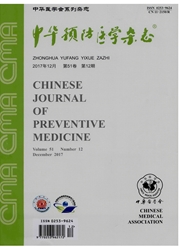

 中文摘要:
中文摘要:
目的了解高碘地区孕妇碘营养状况及其对新生儿甲状腺功能的影响。方法以2010年4-6月河北省海兴县某医院的210名待产孕妇为调查对象,收集孕妇随机尿样及其所产新生儿脐带血,分别测定孕妇尿碘浓度及新生儿血清中游离三碘甲腺原氨酸(FT3)、游离甲状腺素(FT4)及敏感促甲状腺激素(sTSH)水平。对孕妇碘营养状况和新生儿甲状腺功能进行评价并分析二者之间的关系。结果210名孕妇年龄为(27.69±4.73)岁,其尿碘水平的中位数(四分位数间距)为1240.70(1292.68)μg/L。其中,碘过量者(尿碘9500μg/L)占84.3%(177/210),碘超足量者(尿碘250-499μg/L)占13.8%(29/210),碘充足者(尿碘150-249μg/L)占0.5%(1/210),碘不足者(尿碘〈150μg/L)占1.4%(3/210)。新生儿血清中FL、F.r4水平分别为(2.93±0.59)、(15.03±1.92)pmol/L,血清sTSH水平的中位数(四分位数间距)为7.33(5.59)mU/L。新生儿血清sTSH水平〉5mU/L者占78.1%(164/210)。孕妇尿碘水平与新生儿血清FT3、sTSH水平无相关性(P〉0.05),但与FT4水平呈正相关(P〈0.01),碘不足孕妇所产新生儿血清FT4水平[(12.99±1.10)pmol/L]低于碘过量组[(15.16±1.83)pmol/L](P〈0.05)。结论高碘地区大部分孕妇碘营养过量,但仍有少数孕妇存在碘缺乏;该地区新生儿血清sTSH水平较高,应加强对其发生甲状腺功能减退、亚临床甲状腺功能减退的风险进行监测。
 英文摘要:
英文摘要:
Objective To reveal the iodine status of pregnant women and its impact on thyroid function of neonates in high iodine area. Methods A total of 210 pregnant women were chosen from a hospital in Haixing county,Hebei province. Pregnant women's random urinary and neonates' cord blood were collected. The urinary iodine concentration ( UIC ) was examined by arsenic-cerium catalytic speetrophotometry. The levels of free triiodothyronine (FT3 ), free thyroxine (FT4 ) and sensitive thyroid-stimulating hormone (sTSH) in serum were measured by chemiluminescence. Results The age of 210 pregnant women was (27. 69 ± 4. 73 )years old, whose urinary iodine median (inter-quartile range ) was 1240. 70( 1292. 68)μg/L. 84. 3% (177/210) of the pregnant women had excessive iodine intake (UIC ≥ 500 μg/L) , 13.8 % ( 29/210 ) had more than adequate iodine intake ( UIC within 250 - 499 μg/L ) , 0. 5 % (1/210) had adequate iodine intake( UIC within 150- 249 μg/L) and 1.4% (3/210)had insufficient iodine intake( UIC 〈 150 μg/L). The average serum level of FT3 , FT4 in neonates were ( 2. 93 ± 0.59 ) , (15.03 ± 1.92 )pmol/L, respectively. The median (inter-quartile range) of serum sTSH in neonates were 7.33(5.59) mU/L. 78.1% (164/210) of the neonates' serum TSH were beyond 5 mU/L. There were no correlation between pregnant women's urinary iodine level and neonates' serum FT3 and sTSH level( P 〉 0. 05),but there was a positive correlation between pregnant women's urinary iodine level and neonates'serum FT4 level(P〈 0. 01 ). Serum FT4 level of the neonates with whose mothers had insufficient iodine intake ( ( 12.99 ± 1.10) pmol/L) were statistically lower than those with their mothers had excessive iodine intake( ( 15.16 ± 1.83 ) pmol/L) ( P 〈 0. 05 ). Conclusion Most of the pregnant women in high iodine area were excessive for iodine nutrition, but still a few pregnant women had insufficient iodine nutrit
 同期刊论文项目
同期刊论文项目
 同项目期刊论文
同项目期刊论文
 Exploration of the safe upper level of iodine intake in euthyroid Chinese adults: a randomized doubl
Exploration of the safe upper level of iodine intake in euthyroid Chinese adults: a randomized doubl 期刊信息
期刊信息
